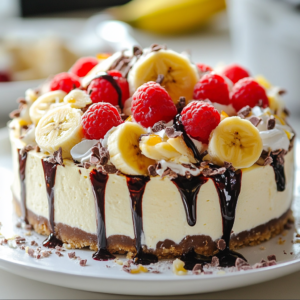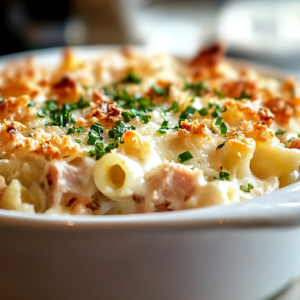Scrapbooking is a captivating art form that allows you to preserve your cherished memories, stories, and moments in a visually stunning way. Whether you’re a seasoned crafter or a beginner, exploring the world of creative scrapbooking techniques can be an immensely rewarding experience. In this comprehensive article, we’ll delve into the fundamentals of scrapbooking and uncover a variety of techniques that will inspire you to create your own masterpieces.
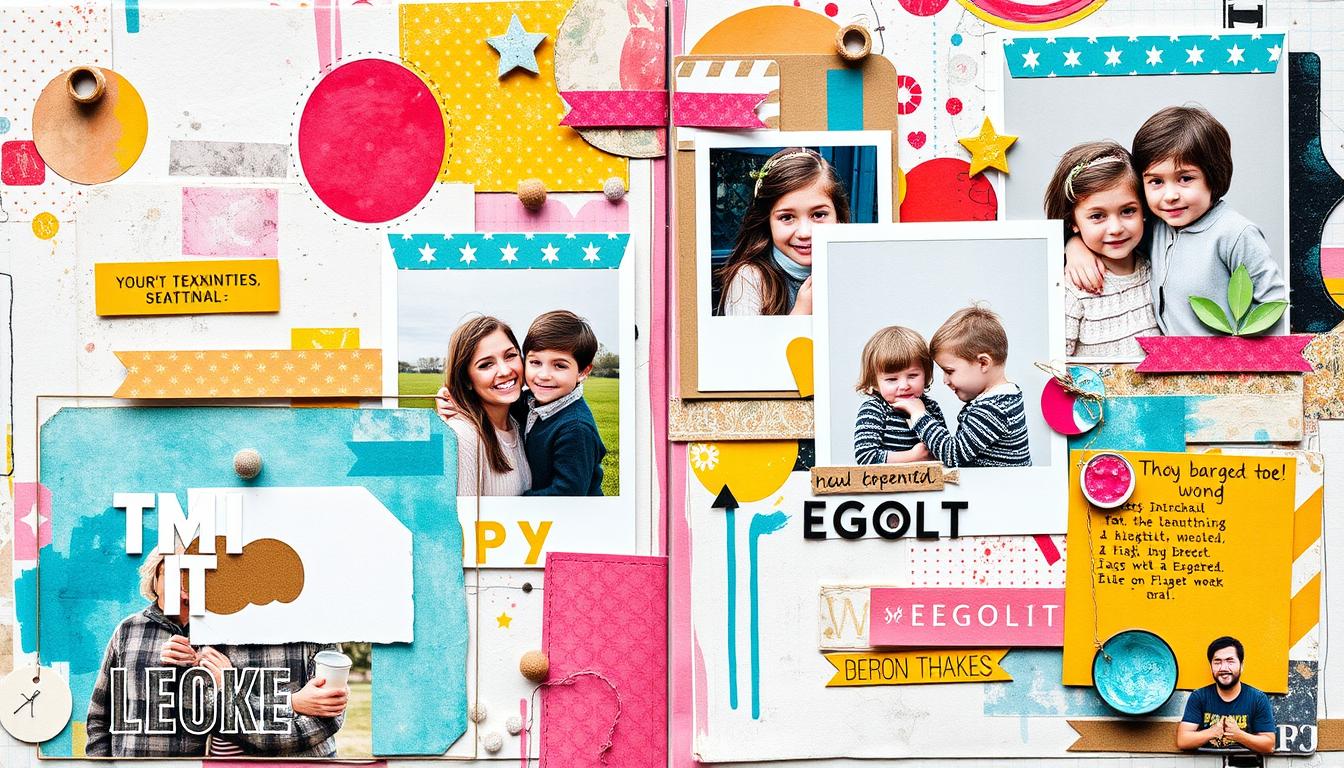
From understanding the core purpose of scrapbooking to mastering the essential tools and supplies, this guide will equip you with the knowledge and skills needed to embark on your scrapbooking journey. We’ll also explore the art of choosing meaningful themes, designing visually appealing layouts, and incorporating personalized elements that truly capture the essence of your memories. Prepare to unleash your creativity and discover the joy of preserving your life’s most cherished moments through the art of scrapbooking.
So, let’s dive in and explore the world of scrapbooking supplies and techniques that will help you create captivating scrapbook layouts and unlock your artistic potential.
Understanding Scrapbooking
Scrapbooking is a creative and meaningful way to preserve cherished memories and tell your unique story. It involves the art of arranging photographs, memorabilia, and personal embellishments on pages to create visually stunning scrapbook layouts. This captivating hobby allows you to immortalize your life’s moments and express your individual style.
What is Scrapbooking?
At its core, scrapbooking is the process of curating and embellishing pages with photographs, journaling, and various decorative elements. By combining these components, scrapbookers create personalized keepsakes that capture the essence of their experiences and emotions.
The Purpose of Scrapbooking
- Preserving Memories: Scrapbooking is a means of safeguarding cherished memories, ensuring they are not lost to the sands of time.
- Storytelling: Each scrapbook page tells a unique story, allowing you to share your life’s experiences and the people, places, and events that have shaped you.
- Creative Expression: Scrapbooking provides a creative outlet, enabling you to infuse your pages with your personal style and artistic flair.
Popular Scrapbooking Styles
There are several distinct approaches to scrapbooking, each with its own unique characteristics and appeal:
- Traditional Scrapbooking: This classic style involves the use of physical materials, such as patterned papers, stickers, and various embellishments, to create tactile and visually striking pages.
- Digital Scrapbooking: In this modern approach, scrapbookers use digital tools and software to design and assemble their pages, often incorporating digitized photographs and digital elements.
- Hybrid Scrapbooking: A blend of traditional and digital techniques, hybrid scrapbooking allows for the seamless integration of physical and digital elements on the same page.
Regardless of the approach, the essence of scrapbooking remains the same: to create cherished keepsakes that immortalize your life’s most meaningful moments.
Essential Tools for Scrapbooking
Scrapbooking is a creative and rewarding hobby, but it requires the right tools and supplies to make the process enjoyable and efficient. Whether you’re a beginner or an experienced scrapbooker, having the essential tools on hand can elevate your projects and help you achieve professional-looking results. Let’s explore the basic supplies you need, recommended brands for beginners, and advanced tools for more complex techniques.
Basic Supplies You Need
The foundation of any scrapbooking project starts with a few essential items. These include:
- Scrapbooking albums or binders to house your pages
- Refill pages or inserts to add to your albums
- Scissors, both regular and specialty shapes
- Adhesives, such as glue sticks, double-sided tape, or photo-safe liquid glue
- Cardstock and patterned paper for creating backgrounds and accents
- Journal pens or markers for adding text and journaling
- Paper trimmers or cutters for precise trimming and cutting
Recommended Brands for Beginners
When starting out in scrapbooking, it’s helpful to choose reliable and well-known brands that cater to the needs of beginners. Some popular and trustworthy options include:
| Category | Recommended Brands |
|---|---|
| Albums and Refill Pages | Becky Higgins, Creative Memories, 12×12 Scrapbook Albums |
| Adhesives | Tombow, Scrapbook Adhesives by 3L, Ranger |
| Paper and Embellishments | Stampin’ Up!, Simple Stories, Pebbles Inc. |
| Tools | Fiskars, Cutterbee, We R Memory Keepers |
Tools for Advanced Techniques
As you progress in your scrapbooking journey, you may want to explore more advanced techniques that require specialized tools. These can include:
- Die-cut machines for intricate shapes and designs
- Embossing folders and hot foil stampers for adding texture and shine
- Acrylic paint, brushes, and inks for mixed media effects
- Specialty punches and cutting tools for creating custom edges and shapes
With the right scrapbooking supplies and tools, you’ll be well on your way to creating stunning Creative Scrapbooking Techniques that capture your memories in a visually captivating way.
Choosing a Theme for Your Scrapbook
Crafting a captivating scrapbook layout starts with selecting the right theme. Whether you’re preserving memories of a special occasion or documenting your travels, thematic scrapbooking can take your scrapbook layouts to new creative heights. Let’s explore some inspiring ideas to help you choose the perfect theme for your next Creative Scrapbooking Techniques project.
Seasonal Themes
Celebrate the changing seasons by designing scrapbook pages around specific times of the year. From summery beach scenes to cozy autumn tones, seasonal themes allow you to capture the unique mood and energy of each season. Consider incorporating seasonal colors, patterns, and embellishments to enhance the thematic elements of your layouts.
Milestone Events
Major life events, such as weddings, graduations, and new babies, provide a natural and meaningful theme for your scrapbook pages. Showcase cherished moments, milestones, and the emotions surrounding these momentous occasions. Incorporate personal keepsakes, candid photos, and heartfelt journaling to create a cohesive and sentimental scrapbook layout.
Travel Inspirations
Relive the adventures and experiences of your travels by creating scrapbook layouts inspired by your destinations. Whether it’s a weekend getaway or an international expedition, capture the sights, sounds, and vibrant cultural elements of your journeys. Experiment with map motifs, ticket stubs, and other travel-themed embellishments to transport your readers to these faraway places.
Regardless of the theme you choose, the key is to infuse your scrapbook pages with personal significance and a cohesive visual narrative. By carefully selecting a theme, you can transform your scrapbook layouts into stunning displays of your life’s most cherished memories and experiences.
Layout Design Basics
Crafting visually captivating scrapbook layouts is an essential aspect of the Creative Scrapbooking Techniques. Understanding the principles of layout design can elevate your scrapbook pages and make them truly stand out. In this section, we’ll explore the fundamentals of balance, alignment, and the strategic use of white space to create dynamic and engaging scrapbook layouts.
Understanding Balance and Alignment
Balance is a crucial element in scrapbooking. Achieving a balanced layout ensures that your page feels cohesive and visually appealing. This can be accomplished through symmetrical or asymmetrical arrangements, depending on the desired aesthetic. Proper alignment of elements, such as photos, text, and embellishments, can also contribute to a polished and professional-looking scrapbook layout.
Incorporating White Space
Contrary to popular belief, the strategic use of white space can be just as impactful as the elements you choose to include. Negative space, or the areas of your layout without any visual elements, can create a sense of breathing room and draw the viewer’s eye to the focal points of your design. Mastering the art of incorporating white space can prevent your scrapbook layouts from feeling cluttered or overwhelming.
Techniques for Layering Elements
Layering is a powerful technique that can add depth, texture, and visual interest to your scrapbook layouts. By overlapping photos, papers, and embellishments, you can create a multi-dimensional effect that adds complexity and sophistication to your designs. Experiment with different layering techniques, such as overlapping, stacking, and floating, to discover the combinations that best suit your scrapbooking style and the story you’re trying to tell.
Incorporating these layout design basics into your scrapbook layouts will elevate your Creative Scrapbooking Techniques and help you craft pages that captivate and inspire.
Photo Selection and Arrangement
Crafting captivating scrapbook layouts starts with the selection and arrangement of your photos. As a beginner in the world of Creative Scrapbooking Techniques, mastering this crucial step can elevate your pages to new heights. Let’s dive into the art of photo selection and arrangement for maximum visual impact.
Tips for Choosing the Right Photos
The key to a successful scrapbook layout is choosing the right photos that tell a compelling story. Here are some tips to help you select the most impactful images:
- Focus on capturing emotions and moments, not just posed shots.
- Choose a mix of portrait, landscape, and square-format photos for visual interest.
- Prioritize high-quality, well-lit, and in-focus images.
- Consider the colors and tones of your photos to create a cohesive palette.
- Avoid cluttering your layout with too many similar photos.
Arranging Photos for Maximum Impact
Once you’ve selected your photos, it’s time to arrange them in a way that captivates your audience. Experiment with different photo arrangement techniques to find the perfect balance and flow:
- Play with asymmetrical layouts to create visual interest.
- Cluster related photos together to tell a story.
- Use overlapping and layering techniques to add depth and dimension.
- Incorporate negative space to draw the eye to your focal points.
- Experiment with grid-based and freeform layouts to suit your style.
Remember, the art of photo arrangement is all about finding the perfect balance between creativity and cohesion. With a little practice and experimentation, you’ll be crafting captivating scrapbook layouts that showcase your treasured memories in the most visually striking way.
Incorporating Text and Journaling
Scrapbooking is not just about arranging photos; it’s also an opportunity to weave a captivating narrative through thoughtful text and journaling. By incorporating creative writing techniques and intentional font choices, you can elevate your scrapbook layouts and bring your memories to life.
Creative Writing Tips
Crafting engaging journaling can be a daunting task, but with a few simple strategies, you can transform mundane details into captivating stories. Start by focusing on the who, what, when, where, and why of each moment. Infuse your journaling with vivid descriptions, personal anecdotes, and even a touch of humor to make your words shine.
Choosing Fonts and Styles
The font and style you choose for your journaling can have a significant impact on the overall aesthetic of your scrapbook pages. Select fonts that complement the theme and mood of your layout. Experiment with a variety of sizes, weights, and alignments to create visual interest and hierarchy. Handwritten elements can also add a personal touch and a sense of authenticity to your scrapbook.
Placement Ideas for Text
- Incorporate journaling directly onto your photos, either through handwriting or digital overlays.
- Use text blocks or journaling cards to nestle your stories among the other design elements.
- Explore creative placements, such as along the edges of the page, in the corners, or even vertically to break up the traditional layout.
- Don’t be afraid to experiment with different orientations, such as diagonal or staggered text, to add visual interest.
By mastering the art of incorporating text and journaling, you can elevate your scrapbooking to new heights, transforming your pages into rich, storytelling canvases that capture the essence of your memories. Embrace the power of the written word and let your creativity shine through!
Using Color Effectively
Color is a powerful element in scrapbooking that can make or break your layouts. Mastering the art of color selection and combination is crucial for creating visually stunning scrapbook layouts. In this section, we’ll explore the color wheel, guide you through choosing harmonious color palettes, and highlight color combinations to avoid.
The Color Wheel Explained
The color wheel is a essential tool for understanding color relationships. It demonstrates the primary colors (red, yellow, and blue), secondary colors (orange, green, and purple), and how they interact. By familiarizing yourself with the color wheel, you’ll be able to identify complementary, analogous, and triadic color schemes to enhance your Creative Scrapbooking Techniques.
Choosing a Color Palette
- Start with a dominant color that sets the tone for your layout.
- Select 2-3 complementary or analogous colors to create a cohesive palette.
- Consider the mood and theme of your scrapbook when choosing colors.
- Incorporate neutral tones like white, black, or gray to balance the bolder hues.
Color Combinations to Avoid
While color combinations are subjective, certain pairings can create visually jarring effects. Steer clear of:
- Bright neon colors that overwhelm the layout.
- Clashing colors that lack harmony, such as red and green.
- Too many vibrant hues without a clear focal point.
By understanding the color wheel and applying thoughtful color selection, you can elevate your Creative Scrapbooking Techniques and create visually stunning scrapbook layouts that captivate your audience.
Adding Texture and Dimension
Elevate your scrapbooking creations by incorporating texture and dimension. From the strategic use of embellishments to innovative layering techniques, there are numerous ways to add visual interest and depth to your pages. Explore these embellishment ideas and Creative Scrapbooking Techniques to take your layouts to the next level.
Embracing Embellishments
Embellishments are the perfect tools for adding texture and dimension to your scrapbook pages. Experiment with a variety of elements, such as:
- Dimensional stickers and die-cuts
- Fabric scraps, ribbons, and lace
- Buttons, gems, and other three-dimensional accents
- Chipboard shapes and thicker decorative pieces
Layering for 3D Effects
To create a visually stunning layout, consider incorporating 3D techniques. Layering paper, fabrics, and other materials can add depth and a tactile quality to your pages. Try:
- Combining various paper textures and thicknesses
- Mounting photos and elements with foam adhesive for a raised effect
- Incorporating pop-up or accordion-style elements
- Mixing flat and dimensional embellishments for contrast
Exploring Paper Layering
Layering paper is a fundamental Creative Scrapbooking Technique that can elevate your designs. Experiment with different techniques, such as:
| Technique | Description |
|---|---|
| Mats and Frames | Create visual interest by layering photos and elements with colored or patterned paper mats and frames. |
| Overlapping Panels | Overlap paper panels of varying sizes and shapes to add depth and movement to your layout. |
| Torn or Distressed Edges | Tear or distress the edges of your paper layers to create a vintage or artsy look. |
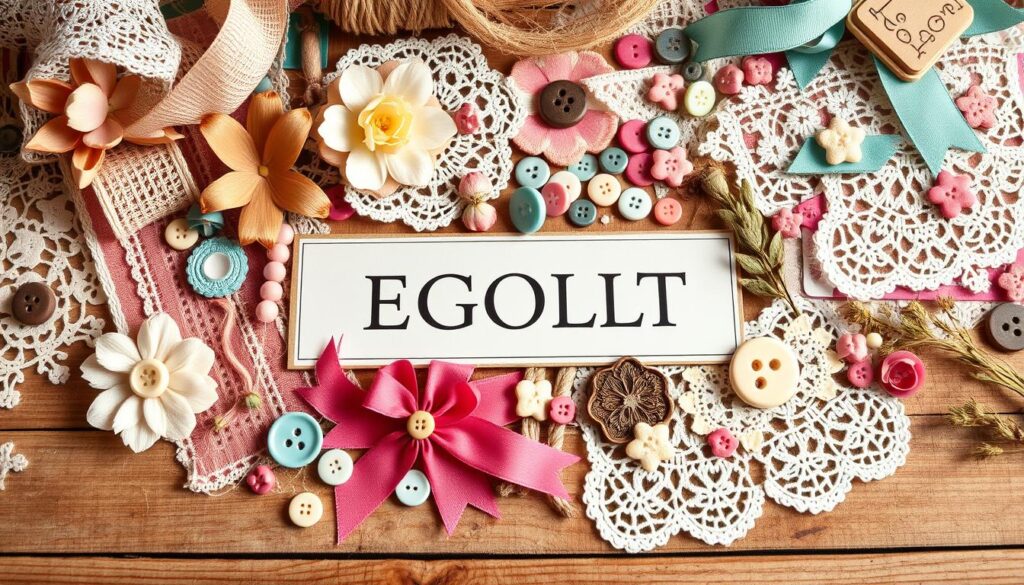
By incorporating these embellishment ideas and Creative Scrapbooking Techniques, you can transform your scrapbook pages into visually captivating masterpieces that are a joy to interact with.
The Power of Mixed Media
In the world of scrapbooking, the art of mixed media techniques is gaining tremendous popularity. Mixed media scrapbooking allows you to unleash your creativity and take your pages to new heights. By blending various materials, textures, and techniques, you can create stunning and one-of-a-kind scrapbook layouts that truly reflect your personal style.
What is Mixed Media Scrapbooking?
Mixed media scrapbooking is a technique that involves combining different media, such as paints, inks, collage elements, and textured materials, to create visually captivating scrapbook pages. This approach encourages experimentation and breaks away from the traditional methods of scrapbooking, allowing you to explore a wider range of artistic expression.
Tools and Materials for Mixed Media
- Acrylic paints and mediums
- Watercolor paints and supplies
- Stamps, stencils, and various mark-making tools
- Collage elements (paper scraps, fabric, lace, ribbons, etc.)
- Gesso, gel medium, and other texture-creating materials
- Mixed media journals or scrapbook albums
Techniques to Try
- Layering and Collage: Build depth and interest by layering different textures, papers, and elements on your scrapbook pages.
- Stamping and Stenciling: Use a variety of stamps and stencils to create patterns, backgrounds, and focal points.
- Painting and Distressing: Experiment with acrylic paints, inks, and techniques like sponging, brushing, and dry-brushing to add depth and character.
- Incorporating Found Objects: Utilize everyday items, such as buttons, beads, and ephemera, to add unique and personal touches to your layouts.
By embracing the power of mixed media techniques, you can unleash your creativity and transform your scrapbooking pages into truly captivating works of art. Explore the endless possibilities and let your imagination soar!
Creative Cutting Techniques
As a passionate scrapbooker, the art of cutting and shaping your materials is a crucial element in elevating your creative expression. In this section, we’ll explore the power of die-cutting, hand cutting, and machine cutting techniques to take your scrapbooking projects to new heights.
Unleashing the Potential of Die-Cuts
Die-cutting is a versatile technique that allows you to create intricate, precise shapes and patterns for your scrapbook pages. From delicate floral motifs to bold geometric designs, die-cuts can add depth, texture, and visual interest to your layouts. Experiment with a variety of die-cut materials, including paper, cardstock, and even fabric, to discover the perfect medium for your die-cutting inspiration.
Hand Cutting vs. Machine Cutting: Embracing the Contrast
While die-cutting offers a streamlined, efficient approach, the art of hand cutting can add a personal touch and unique flair to your Creative Scrapbooking Techniques. Use sharp scissors or craft knives to carefully cut out shapes, letters, and embellishments, allowing you to customize every element to your liking. Contrast the precise, machine-cut elements with the organic, handcrafted touches for a captivating visual harmony.
Exploring Creative Edges and Shapes
Step beyond the traditional rectangular and square shapes and embrace the endless possibilities of creative cutting techniques. Experiment with scalloped edges, serrated borders, and whimsical silhouettes to add visual interest and depth to your scrapbook layouts. These creative cutting techniques can transform even the simplest of elements into showstopping features that elevate your entire design.
Unleash your creativity and let the art of cutting be your guide as you embark on your die-cutting inspiration and Creative Scrapbooking Techniques journey. Embrace the versatility of these cutting techniques to elevate your scrapbooking artistry and produce layouts that truly capture the essence of your memories.
Personalizing Your Scrapbook
Elevating your scrapbook layouts to a truly personalized and meaningful level can be achieved through a variety of creative techniques. From adding handwritten elements to incorporating personal artwork and utilizing family mementos, the possibilities for customizing your scrapbook are endless.
Adding Handwritten Elements
Incorporate the personal touch of handwriting to your scrapbook pages. Whether it’s journaling, titles, or even doodles, handwritten elements add a unique, heartfelt quality to your layouts. Experiment with different pen styles, calligraphy, or even your own distinctive handwriting to make each page truly one-of-a-kind.
Incorporating Personal Art
If you have a knack for creating creative scrapbooking techniques, weave your own original artwork into your scrapbook layouts. This could include hand-drawn illustrations, painted backgrounds, or collage elements made from your own creations. Infusing your personal artistic flair is a wonderful way to make your scrapbook a genuine reflection of your unique style and interests.
Using Family Mementos
- Incorporate cherished family mementos, such as old letters, ticket stubs, or even small trinkets, to add depth and meaning to your scrapbook pages.
- These personal items can serve as the starting point for storytelling, helping you capture the memories and emotions behind the moments you’re preserving.
- Thoughtfully incorporating these mementos can transform your scrapbook into a true family heirloom, to be passed down and treasured for generations.
By embracing these personalized techniques, you can elevate your creative scrapbooking journey and create a scrapbook that is truly a reflection of your unique story and style.
Finding Inspiration
As a passionate scrapbooker, discovering new sources of inspiration can breathe life into your creative projects. From online communities to hands-on workshops, there are countless ways to ignite your imagination and hone your Creative Scrapbooking Techniques.
Online Resources and Communities
The digital age has revolutionized the world of scrapbooking, offering a wealth of scrapbooking supplies and inspiration at your fingertips. Explore online forums, blogs, and social media platforms where scrapbookers share their latest creations, techniques, and insights. Join these vibrant communities to connect with like-minded individuals, exchange ideas, and stay updated on the latest trends.
Craft Shows and Workshops
Attending local and regional craft shows can be a treasure trove of inspiration. Witness the stunning work of seasoned scrapbookers, attend hands-on workshops, and discover unique scrapbooking supplies that may ignite your creativity. These events provide valuable opportunities to learn from experts, network with fellow enthusiasts, and immerse yourself in the vibrant scrapbooking community.
Visiting Art Galleries
Stepping outside the realm of traditional scrapbooking can also spark new ideas. Explore art galleries, museums, and exhibitions to draw inspiration from the diverse techniques, color palettes, and compositions used by renowned artists. Observe how they layer textures, incorporate found objects, and blend mediums to create visually captivating works of art. These experiences can translate into fresh approaches to your own Creative Scrapbooking Techniques.
Remember, the key to sustained inspiration is to stay curious, explore new avenues, and trust your creative instincts. By tapping into these diverse sources of inspiration, you’ll unlock a world of possibilities and elevate your scrapbooking to new heights.
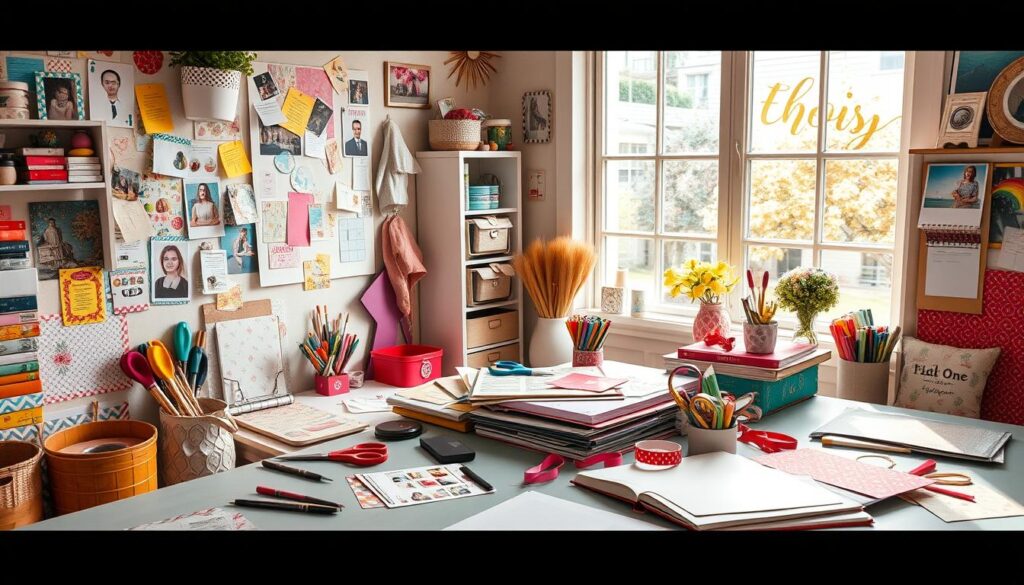
Tips for Staying Organized
Maintaining organization is key when it comes to scrapbooking supplies and the creative process. By implementing a few simple strategies, scrapbookers can streamline their workflow and focus on the enjoyment of Creative Scrapbooking Techniques.
Keeping Your Supplies Tidy
One of the most crucial steps in staying organized is ensuring your scrapbooking supplies are neatly stored and easily accessible. Invest in storage solutions, such as drawers, bins, or clear containers, to house your various papers, embellishments, and tools. Label each container to quickly identify its contents, and arrange them in a way that makes sense for your creative process.
Organizing Photos Efficiently
Scrapbooking often revolves around the use of cherished photographs. To streamline the photo selection process, consider organizing your digital or printed images into themed folders or albums. This will make it easier to find the perfect shots for your Creative Scrapbooking Techniques when you’re ready to start a new project.
Planning Your Pages in Advance
Before diving into the creative process, take the time to plan out your scrapbook pages. Sketch out layout ideas, choose color schemes, and gather the necessary scrapbooking supplies. This will not only help you stay organized but also provide a clear roadmap for executing your vision, making the overall scrapbooking experience more enjoyable and efficient.
By implementing these organizational strategies, scrapbookers can create a well-structured and visually stunning scrapbook that showcases their Creative Scrapbooking Techniques to the fullest.
Overcoming Creative Blocks
Crafting your scrapbook can be a rewarding and fulfilling experience, but even the most seasoned scrapbookers can occasionally face creative blocks. Whether it’s struggling to find the right layout, feeling uninspired by your photo selections, or simply hitting a mental roadblock, these challenges can be frustrating. However, with the right mindset and strategies, you can overcome these creative obstacles and reignite your passion for Creative Scrapbooking Techniques.
Common Causes of Creative Blocks
Creative blocks can stem from a variety of factors, such as feeling overwhelmed by the endless possibilities, a lack of motivation, or even fatigue from long hours spent crafting. Burnout, self-doubt, and a disconnect from your personal style can also contribute to a creative slump.
Tips to Get Your Creativity Flowing
When faced with a creative block, try stepping away from your scrapbook and engaging in activities that inspire you. Browse scrapbook layouts online for fresh ideas, attend a local craft workshop, or simply take a walk in nature to clear your mind. Experimenting with new techniques or materials can also reignite your creative spark.
The Importance of Taking Breaks
Remember, creativity is not a boundless resource; it requires rest and rejuvenation. Take regular breaks from your scrapbooking projects to recharge, whether it’s a few hours, a day, or even a week. This time away can help you gain a fresh perspective and return to your craft with renewed energy and enthusiasm.


